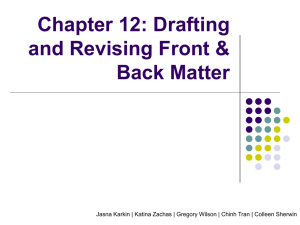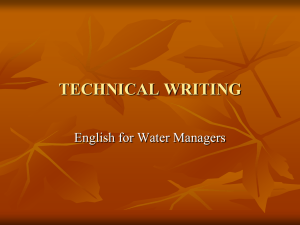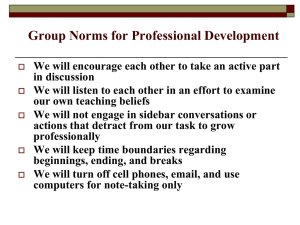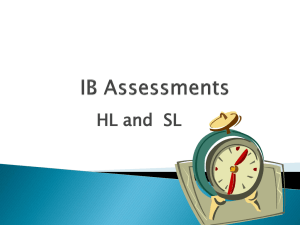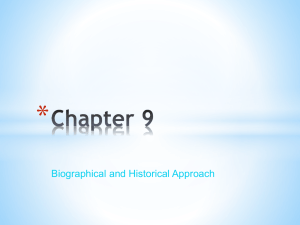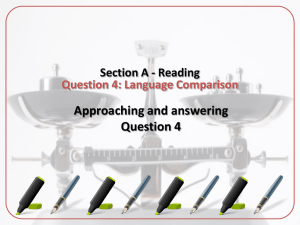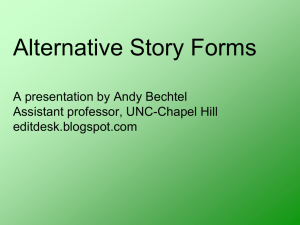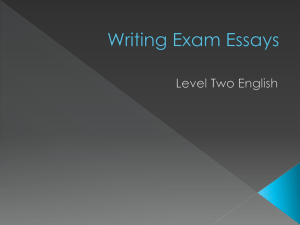News and Language
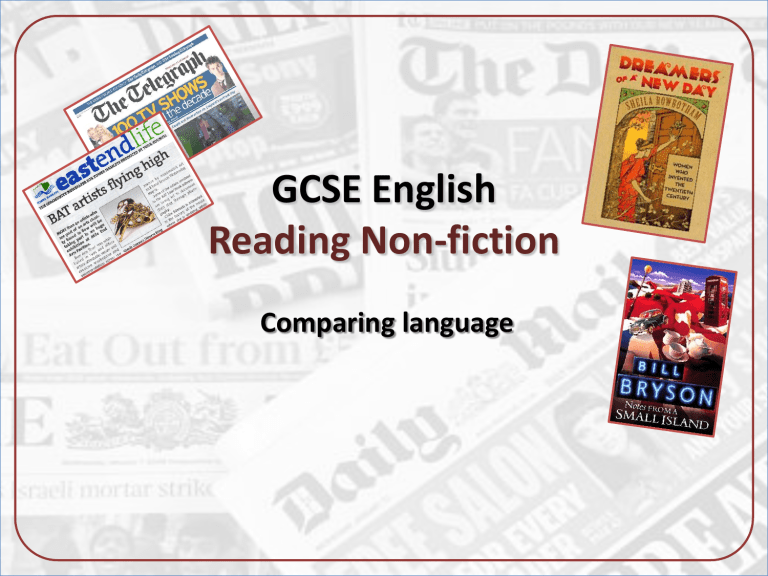
GCSE English
Reading Non-fiction
Comparing language
GCSE English
Reading Non-fiction
Lessons 1&2
LO: Can I analyse non-fiction writers’ use of language in detail?
Key words: Devices, Effects, Reader response
Common linguistic / literary features…
• 1st, 2nd or 3rd person
(narrative viewpoint)
• Directly addressing the reader
• Imperatives (commands)
• Rhetorical questions
• Register - formal/informal language
• Diction - simple/complex vocabulary
• Figurative language & imagery: similes/metaphor/ personification etc.
• Word play & puns
• Alliteration
• Rhyme & rhythm
• Anecdote & allusion
• Slogan & catchphrase
• Statistics & facts
• Exaggeration & hyperbole
• Repetition
• Humour
• Sensory language
• Emotive language
• Punctuation type
• Expert advice
• Short sentences
• Superlatives
• Lists
Which language devices can you identify? What kind of text?
IN GROUPS
“…budget cut from about £16m to £10m over three years…”
“Chris Ready, Wigan council's portfolio holder for leisure, said: “We have a proud history of investing in sport in Wigan borough…””
“That proposal was, Sebastian Coe said,
“entirely based on a properly resourced replacement track and field facility in
Sheffield”.”
1.
“We were on a mission. As we turned into our road from the alleyway, a quiet buzzing sound drifted over us. We knew we were on our way.”
“Our mouths dropped in awe. We didn’t know the word then, but now we knew the feeling. A sea of coloured banners, waves of red and white crashing into shores of blue and white, was rolling off the motorway, driving right past us.”
2.
“After all this, will we just keep on watching as it keeps on happening, again and again? When will we come to our senses?”
“If we could create a Garment Workers Welfare
Trust in Bangladesh with that additional 50 cents, we could resolve most of the problems workers face – safety, work environment, pensions, healthcare, housing, their children's health, education, childcare, retirement, old age and travel.”
3.
“He puts so much butter on them that it runs through the holes and down our arms as we pull at the soft, warm dough with our teeth. We all run our fingers round our plates and lick the stray butter off them. Everyone is so quiet. Both of them have red eyes like white rabbits.”
“Mum starts to roll the pastry out, concentrating hard, like every push is a piece of mathematics.
‘Here, you have a go, darling.’”
4.
Which text do your short excerpts belong to?
Why were these texts created, and who for?
Does their purpose and audience affect the kind of language they use?
Why writers use particular kinds of language…
Humour
This often ‘wins over’ the reader, making them more likely to be sympathetic to the writer’s point of view.
Facts, statistics and expert advice
These features authenticate a text.
They make it more real and believable – we are more likely to trust the text.
Sensory description
This can create / evoke a clear image and sense of the thing being described in the mind of a reader.
IN PAIRS
In the
GCSE English Language exam
, you are expected to both read and write different kinds of non-fiction. This unit focuses on the reading section of the paper, which asks you to read and respond to texts in certain ways. You are asked…
1. To
retrieve
information and
explain
it to show you’ve fully understood a text (usually a newspaper article)
2. To
analyse
a text’s presentational features, such as headlines and images, and
link
them to the text (again – usually a newspaper article)
3. To
infer
meanings, ideas, thoughts, feelings etc. from a text – to ‘read between the lines’ (usually a descriptive piece)
4. To
compare
the use of language in two non-fiction texts.
This question is worth 16 marks. You’re always asked to compare Source 3 (the descriptive piece) to either Source 1 or Source 2. The question is:
Compare the different ways language is used for effect in the two texts. Give some examples and analyse what the effects are.
(16 marks)
Analysing / comparing language is not a case of ‘technique spotting’, then providing a generic
‘effect’ for each text. How has this student analysed language? Where have they identified writers’ techniques, and where do they speak more generally about language?
Both Text 2 and 3 use shock tactics. Phrases such as
“splattered with each other’s blood” and “her abaya stained red” shock the reader with their graphic imagery and add to the interest for the reader. The whole article is very descriptive, which enables the reader to picture the “highways of death” and
“plumes of smoke”. Text 3 uses shock tactics, but for a different purpose: to make the reader feel guilt, which in turn makes them feel compelled to donate.
For example “thousands of children have been killed” and “still in real danger” induce a feeling of responsibility onto the reader. Furthermore, words such as “urgently” and “please help” further reiterate the persuasive style of this text.
IN PAIRS
Analysing / comparing language is not a case of ‘technique spotting’, then providing a generic
‘effect’ for each text. How has this student analysed language? Where have they identified writers’ techniques, and where do they speak more generally about language?
Both articles use emotive and powerful language but in different ways. Text 2’s headline uses military words such as “blasted”, “missile” and “targeted”; these words link with an article about a war torn part of the world where violence is a fact of life. The harsh, sibilant sounds of these words reinforce the violence of their meanings. Similarly, Text 3 uses the word “emergency” to make the reader take notice.
The verbs “help” and “save”, skilfully suggest to the reader that they need to take action and the use of the inclusive “us” makes the reader feel part of a team doing good. In addition the words “lives” and
“children” make an appeal to the reader’s emotions as they think that it is serious if lives are at risk and that vulnerable and innocent children can be helped.
IN PAIRS
3.
4.
1.
2.
IN GROUPS
Question : How is language is used for effect in this text. Give some examples and analyse what the effects are.
3.
4.
1.
2.
IN GROUPS
Question : How is language is used for effect in this text. Give some examples and analyse what the effects are.
3.
4.
1.
2.
IN GROUPS
Question : How is language is used for effect in this text. Give some examples and analyse what the effects are.
3.
4.
1.
2.
IN GROUPS
Question : How is language is used for effect in this text. Give some examples and analyse what the effects are.
3.
4.
1.
2.
IN GROUPS
Question : How is language is used for effect in this text. Give some examples and analyse what the effects are.
3.
4.
1.
2.
IN GROUPS
Question : How is language is used for effect in this text. Give some examples and analyse what the effects are.
GCSE English
Reading Non-fiction
Lessons 3&4
LO: LO: Can I write comparatively about language and its effect?
Key words: Devices, Effects, Reader response
You will usually be comparing an ‘information’, news-type text…
…with a ‘narrative’, story-type text.
Useful connectives…
Showing similarities
…is similar to…; similarly; like/likewise; equally; as with…; moreover…; in the same way…; in a similar way…
For differences
…in contrast to…; alternatively…; compared with…; in comparison with…; …is different from…; on the other hand; instead of…; however; otherwise…; whereas…; unlike…
IN PAIRS
‘learns’
Reader’s response to your text?
‘discovers’
‘shocked’
1. Which words / phrases are useful when thinking about reader response?
2. Are any not appropriate?
3. Which need to be used with ‘may’, ‘might’, ‘could’ / ‘perhaps’, ‘possibly’?
Jigsaw Activity
1. A Cook’s Tour and Costa
Coffee article
2. Black Earth City and
British bluebells article
3. Memories of
Auschwitz and giant snails article
Jigsaw Activity
Band 3 (clear, consistent)
Both texts use lists. The ‘bluebells’ story explains the reasons why flowers arrive at different times:
“elevation, latitude, aspect, soils, geology and local climate conditions”. This list gives more information and helps the reader understand the issue being described. On the other hand, ‘Black
Earth City’ uses a list to describe the hostel in
Russia-. People in the hostel “slept, worked, had parties, ate, drank, sulked, wrote letters, cooked smoked and hung out their washing” in this place.
This long list creates an image in the reader’s mind and tells us that the hostel is a very busy and lively place and that there are always things going on.
IN PAIRS
Band 4 (detailed, perceptive)
Both texts use lists, but for different purposes. The
‘bluebells’ story tells readers about the different factors affecting bluebells appearing in British forests; which are “elevation, latitude, aspect, soils, geology and local climate conditions”. This list helps the reader understand the issue being described in the text – it is complex and cold weather is just one factor. On the other hand, ‘Black
Earth City’ uses a list for a descriptive purpose - to convey the activity of the hostel in Russia. We are told the people who live in the hostel “slept, worked, had parties, ate, drank, sulked, wrote letters, cooked…” which gives the impression that this is the centre of their lives . The listing of these verbs creates an image of the “overpopulation” in the hostel; this is a busy, cramped place where occupants don’t get a lot of privacy.
IN PAIRS
Band 3 (clear, consistent)
‘Memories of Auschwitz’ uses facts and statistics to emphasise how bad the Holocaust was - “thousands of prisoners” could be kept in Auschwitz and “£1.5 million” people were killed there. This huge shocks readers as it reveals the scale of murder that took place. The ‘giant snails’ article uses statistics to tell readers about the giant snail infestation in
Florida. “1000” of the snails are caught each week and “117,000” have been caught altogether. Even though this information might surprise the reader, it is unlikely to have the same impact as the shocking statistics in Katie Giles’ account.
IN PAIRS
Band 4 (detailed, perceptive)
‘Memories of Auschwitz’ uses facts and statistics because as well as being a personal account of the author’s trip it aims to make readers reflect on the terrible events of the Holocaust. We are told that
“thousands of prisoners” were kept at Auschwitz at once, which gives us an idea of the scale of the horror that happened in the concentration camp, and are told that “£1.5 million” lost their lives altogether. This staggering number gives us a sense of what it would be like to visit a place of such terrible significance. In a similar way, the ‘giant snails’ article uses statistics to make readers aware of the scale of an issue , this time of a far less serious event- the giant snail infestation in Florida. “1000” of the snails are caught each week and “117,000” have been caught before, which implies that this isn’t a small problem. Readers learn that “1,200” eggs a year are laid so perhaps aren’t surprise the pests are so widespread.
IN PAIRS
Band 3 (clear, consistent)
Both of these texts shock the readers. In the Costa
Coffee article, readers would be surprised to hear that “more than 1,700” people applied for just eight jobs at the coffee chain . This gives us an idea of just how much competition there is for a single job and makes us aware of how bad unemployment is. ‘A
Cook’s Tour’ shocks readers with a gory description of a pig being killed. The writer describes the “fresh blood flying in every direction”. Rule of three is also used -“shrieking, squealing, struggling” – to give readers a clear picture of the pig being slaughtered.
This helps readers understand how upsetting this was.
IN PAIRS
Band 4 (detailed, perceptive)
Both of these texts shock their readers, but in very different ways and using different language techniques to do so. The Costa Coffee article uses shocking statistics to reveal the difficulties facing jobseekers in the UK– “more than 1,700” people applied for just eight jobs at the coffee chain , despite wages being as low as £6.10 an hour.
Moreover, the retail chain HMV is closing “66 of 220
UK stores”, meaning more unemployment in
Britain. ‘A Cook’s Tour’ shocks readers with a highly graphic description of a pig being killed. We are given the vivid image of “fresh blood flying in every direction” and the sensory description of the
“shrieking, squealing, struggling” pig as it is being killed. This alliterative phrase describing the sight and sound of the dying pig suggests the experience left a huge impression on the narrator in contrast to the locals, for whom this is a normal event.
IN PAIRS
Connective
Firstly
Secondly
Thirdly
As well as this
Furthermore
Moreover
Finally
Lastly
Likewise
Similarly
Unlike
As well as
In contrast to
The author / language in the text…
Advises
Argues
Builds
Connotes
Contrasts
Conveys
Creates
Demonstrates
Describes
Depicts
Emphasises
Evokes
Exaggerates
Gives the impression
Gives a sense
Highlights
Informs
Implies
Indicates
Juxtaposes
Narrates
Persuades
Realises
Recognises
Refers to
Reflects
Represents
Reveals
Signifies
Suggests
Symbolises
Shows
Tells
The reader…
(or ‘we’…)
Is made aware
Is informed
Is told
Is shocked / fascinated / persuaded / made to sympathise etc.
Learns
Discovers
Realises



